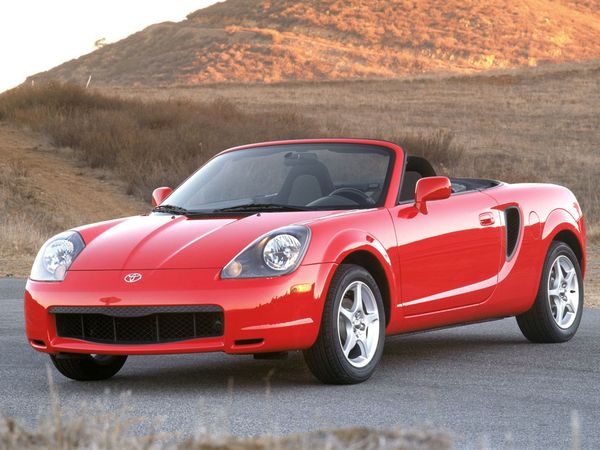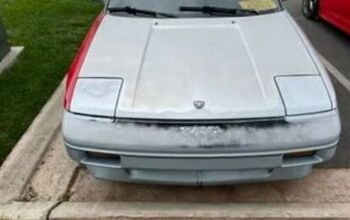Toyota Mulling a Return of the MR2

Starting with the introduction of the 86 (Scion FR-S in North America) in 2012, Toyota began spicing up a brand viewed as being more synonymous with bulletproof reliability than fun. While this manifested itself primarily through more expressive exterior design choices, the brand also introduced performance-tuned GRMN variants in Europe and Japan. It’s also bringing back the Supra, arguably the brand’s most iconic sports car.
Still, a subset of the population looks back at Toyota’s history with a particular fondness for the mid-engined micro machine known as the MR2. Discontinued in 2007, the model was as endearing as it was fun to drive — especially those earlier incarnations, when it looked like a pint-sized Lotus Esprit. And, as luck would have it, Toyota’s European vice president of sales and marketing Matt Harrison says its return isn’t beyond the realms of possibility.
Speaking to Autocar at the Paris Motor Show, Harrison admitted the MR2 is in the “discussion stage” and is a favorite contender among the company’s development teams. Toyota CEO Akio Toyoda previously referred to the Supra, Celica, and MR2 as the “Three Brothers,” noting that he’d like to see them all return — but only if a business case can be made.
That’ll be the tough bit. While we’re happy to see the Supra again, we don’t know if the current consumer climate will give it a warm reception. Meanwhile, the 86 went from 18,327 U.S. deliveries in 2013 to just 6,846 last year — and that was a model everyone seemed to be clamoring for. The MR2 would be even more of a niche automobile.
However, if it remained true to form, it would have its odd place in the market all to itself. There’s not a lot of mid-engined two-seaters priced the same as a Honda Accord in production right now. If only there was some way for Toyota to mitigate the risks involved with producing a fun car that almost nobody is going to buy…
Platform-sharing as part of a joint venture might work. After all, Toyota’s partnership with Subaru delivered the 86 and a deal with BMW is what made the Supra possible. But who else would want to build a petite, affordable laugh with the engine in the wrong place?
Toyota might be stuck trying to build this thing on its own and, if that’s to be the case, Autocar suggests it could emerge as a hybrid or pure electric vehicle. Normally we’d cringe over such a suggestion, but the MR2 might be the perfect candidate for electrification. Since it’s sure to be small and lightweight, it’ll have the most to gain from a battery pack and e-mill. It doesn’t have to be practical or excel at long road trips, it just needs to be quick and fun — which an electric motor provides through gobs of instantaneous torque.
Obviously, we’re getting way ahead of ourselves here. Toyota hasn’t confirmed anything and the MR2 doesn’t seem like it’d be a high-volume vehicle in even our wildest fantasies. But the brand has said it wants to build several new BEVs by the mid 2020s and Harrison doesn’t seem opposed to the idea of one of them being an MR2. Would you be interested?
[Images: Toyota]

A staunch consumer advocate tracking industry trends and regulation. Before joining TTAC, Matt spent a decade working for marketing and research firms based in NYC. Clients included several of the world’s largest automakers, global tire brands, and aftermarket part suppliers. Dissatisfied with the corporate world and resentful of having to wear suits everyday, he pivoted to writing about cars. Since then, that man has become an ardent supporter of the right-to-repair movement, been interviewed on the auto industry by national radio broadcasts, driven more rental cars than anyone ever should, participated in amateur rallying events, and received the requisite minimum training as sanctioned by the SCCA. Handy with a wrench, Matt grew up surrounded by Detroit auto workers and managed to get a pizza delivery job before he was legally eligible. He later found himself driving box trucks through Manhattan, guaranteeing future sympathy for actual truckers. He continues to conduct research pertaining to the automotive sector as an independent contractor and has since moved back to his native Michigan, closer to where the cars are born. A contrarian, Matt claims to prefer understeer — stating that front and all-wheel drive vehicles cater best to his driving style.
More by Matt Posky
Latest Car Reviews
Read moreLatest Product Reviews
Read moreRecent Comments
- Kjhkjlhkjhkljh kljhjkhjklhkjh A prelude is a bad idea. There is already Acura with all the weird sport trims. This will not make back it's R&D money.
- Analoggrotto I don't see a red car here, how blazing stupid are you people?
- Redapple2 Love the wheels
- Redapple2 Good luck to them. They used to make great cars. 510. 240Z, Sentra SE-R. Maxima. Frontier.
- Joe65688619 Under Ghosn they went through the same short-term bottom-line thinking that GM did in the 80s/90s, and they have not recovered say, to their heyday in the 50s and 60s in terms of market share and innovation. Poor design decisions (a CVT in their front-wheel drive "4-Door Sports Car", model overlap in a poorly performing segment (they never needed the Altima AND the Maxima...what they needed was one vehicle with different drivetrain, including hybrid, to compete with the Accord/Camry, and decontenting their vehicles: My 2012 QX56 (I know, not a Nissan, but the same holds for the Armada) had power rear windows in the cargo area that could vent, a glass hatch on the back door that could be opened separate from the whole liftgate (in such a tall vehicle, kinda essential if you have it in a garage and want to load the trunk without having to open the garage door to make room for the lift gate), a nice driver's side folding armrest, and a few other quality-of-life details absent from my 2018 QX80. In a competitive market this attention to detai is can be the differentiator that sell cars. Now they are caught in the middle of the market, competing more with Hyundai and Kia and selling discounted vehicles near the same price points, but losing money on them. They invested also invested a lot in niche platforms. The Leaf was one of the first full EVs, but never really evolved. They misjudged the market - luxury EVs are selling, small budget models not so much. Variable compression engines offering little in terms of real-world power or tech, let a lot of complexity that is leading to higher failure rates. Aside from the Z and GT-R (low volume models), not much forced induction (whether your a fan or not, look at what Honda did with the CR-V and Acura RDX - same chassis, slap a turbo on it, make it nicer inside, and now you can sell it as a semi-premium brand with higher markup). That said, I do believe they retain the technical and engineering capability to do far better. About time management realized they need to make smarter investments and understand their markets better.



































Comments
Join the conversation
“...but only if a business case can be made.” There endth the story.
Partner with GM. They can sell their version as the Fiero.